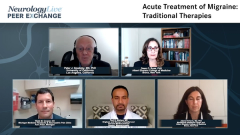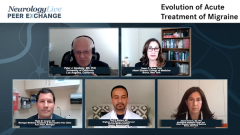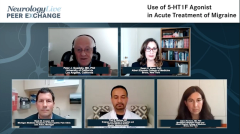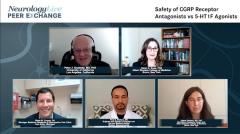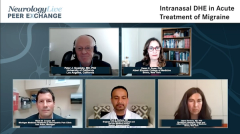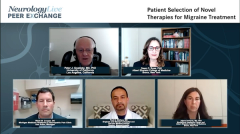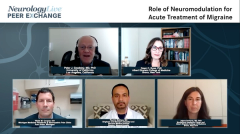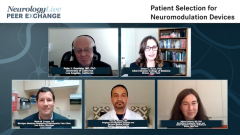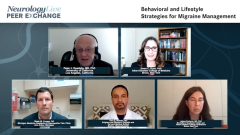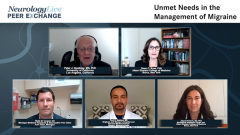
Behavioral and Lifestyle Strategies for Migraine Management
Episodes in this series

Dawn C. Buse, PhD, provides insight on behavioral and lifestyle strategies, such as SEEDSS (sleep, exercise, eat, diary, stress management, social support), and looks at efficacy and challenges for people living with migraine.
Peter J. Goadsby, MD, PhD: As I think about things that are safe and important, we don’t want to leave the nonpharmacological area without having 1 of the world’s experts tell us a bit about behavioral therapies and lifestyle strategies for migraines. We should not overlook those in the excitement about neuromodulation and pharmacology. Dawn?
Dawn C. Buse, PhD: Thank you, Peter. These biobehavioral techniques are going to be a wonderful complement to new therapies. There are the big 3 biobehavioral techniques with strong evidence, which are AAN [American Academy of Neurology] Guideline recommended. Those are biofeedback, cognitive behavioral therapy, and relaxation therapies. They’re often done in combination.
As I mentioned, they have decades of experience, are supported by hundreds of studies, and are guideline recommended. The efficacy is strong. When you look at the efficacy of traditional oral preventives on their own vs 1 of these 3 biobehavioral approaches on their own, we saw similar rates of efficacy. They were both in the 40%-to-50% improvement range. The really nice thing is that in multiple well-done studies, when we combined the traditional oral treatments with 1 or more of these biobehavioral therapies, we saw improvement rates in the 75% range.
These studies have not been done with these new treatment classes, but I look forward to that. Clinically, it’s not too much of a leap to say that they are a lovely complement to any approved preventive therapy or acute therapy. We do tend to think of them preventively, but we know that lying down, relaxing your sympathetic nervous system, listening to pleasant meditations, or doing another relaxing breathing activity can only help in the throes of migraine attack.
Much like neurostimulation, their biggest challenges come in the form of access. It can be difficult to find a provider. It can be challenging to get insurance approval, although not always. I was a psychologist at the Montefiore Headache Center for 13 years. I was on the same panels as all my neurologist colleagues and did have insurance approval for all the patients I saw. But there are not many psychologists out there who are taking insurance who are providing these therapies.
They take time, as opposed to the simplicity of taking a medication. They take more than an hour out of the person’s schedule, plus travel, childcare, and time off work. Going to anywhere from 8 to 12 sessions can be time consuming. The good news is that there are several studies, developments, and programs around the world currently moving these programs to app-based platforms accessible on a smartphone.
There are applications on smart watches. There are also web-based applications in development. There is a lovely publication from colleagues in Norway doing biofeedback on the smartphone for teens. There’s work being done in New York City using progressive muscle relaxation. I’m also working with another couple of groups doing biofeedback on the smartphone, so hopefully in the not-so-distant future, we will be able to deliver services in a very cost-effective, convenient way.
The validation of those nontraditional delivery methods will have to be done to show that they have the same efficacy as an in-clinic experience. These approaches are something to think about that can be done on their own or in combination. They are a wonderful option for pregnancy, prepregnancy, or at any time of life. They also help significantly in medication overuse when combined with traditional medication withdrawal programs. Those are the big 3.
The other areas you may hear about will be mindfulness-based approaches, acceptance and commitment therapy, and dialectical behavior therapy. All 3 of those have incredibly strong research in other areas. Those include depression, anxiety, substance abuse, and others. They have not been strongly validated in migraine, but if you have a patient who is interested in any of those, they can’t hurt. I would certainly encourage them with your well-wishes to explore any of those approaches.
Peter J. Goadsby, MD, PhD: Thanks. That’s a very comprehensive outline.
Dawn C. Buse, PhD: Thank you. Finally, Peter, you also mentioned lifestyle modifications that matter. We can keep it to a pretty short list. There are half a dozen actions that people can take that make a real improvement for their nervous system. I like to tell patients this is exercise for their nervous system. The mnemonic we use is SEEDSS: S for sleep, E for eating and drinking, E for exercise. It does not have to be intense exercise. We can call it movement. D is for keeping a diary, as Paul mentioned earlier. And 2 more Ss, for stress management and social support. There are nice data and studies behind each of those, and what you can do as a physician or health care professional is make those as important as every other medication prescription you write so it is written right next to their prescriptions.
Make sure it is written on their take-home summary from their visit. Ask about it on follow-up. Not to the point where someone feels hounded or embarrassed, but remind them that there are data showing that this will help their nervous system become more resilient, possibly help their medications work better, and definitely help them feel better. Those are the SEEDSS. SEEDSS for success.
Paul G. Mathew, MD: Those are all great points, Dawn. Going back to the therapeutic relationship, if they see the physician as not only a prescriber of medication but a lifestyle coach, that really enhances things. Nowadays, people are looking for more and more of that. There are 2 things I use as hooks. One of them for diet is a cheat day.
I tell them that if Sunday through Friday, you’re very regimented in terms of carbs being earlier in the day, reducing your overall levels, avoiding bad snacks, and really being strict to a diet. Then 1 day a week, have a cheat day on which you can eat whatever you’d like. That gives people the flexibility and the maintenance of sanity. If they have cravings on the noncheat day, they can eat and be good with it, and then eat whatever they want on their cheat day.
The other thing you hinted at, which I often tell people, is that boot camp is great, but it’s sustainable for only a month or 2. After that, people say, “I can’t keep up with this, both for the time and energy commitments.” Incorporating mild-to-moderate exercise a few days a week is really important. That could be something simple. I tell my patients, “while you’re brushing your teeth, that might be a good time to do squats at the same time. You’re just brushing your teeth anyway.” Another method is to do lunges when you’re doing stairs.
Instead of doing 1 step at a time, which really doesn’t give most people much of a cardiovascular stress, do lunges by taking 2 stairs at a time. You’re toning your legs and strengthening those muscles. Little things like that, when done periodically or frequently over time, really add up. Those are the kinds of easy things people can do to improve their overall health, and they’re sustainable.
Dawn C. Buse, PhD: That’s right, Paul. This is a marathon, not a sprint. We can make it a bit fun, make it doable, and possibly even include a family member or friend. For example, you and your spouse will take a walk every night after dinner and your teenager will do the dishes. You write it on a prescription pad. You still have a prescription pad. Write it down so they can put it on their refrigerator and their teenager can see that. Helping them make a plan that is doable, manageable, and even a bit pleasant can really set someone up for continued success and adherence to these sorts of lifestyle changes.
Paul G. Mathew, MD: The other thing that is tremendously helpful is talking up other providers and then reinforcing other providers. The common thing that happens with many of our patients who have neck and back pain is that we send them to physical therapy, they go for 5 sessions, and they feel a little better. Then once it’s over, they feel no better. Give that pretalk. Say, “Listen, you’re going to get some modalities that will help, but it’s when you continue those modalities for weeks to months that you’re really going to see the benefit.”
I use the analogy of going to the gym. No one has a trainer and goes for 5 sessions and says, “Why haven’t I lost 20 pounds yet?” It’s in the continuation of what they taught you that you’re going to see the long-term benefits. Build that bridge before they even see the other provider, and then periodically follow up. Say, “Have you been doing your stretches? Have you been following the nutrition recommendations?” That reinforcement really brings everyone on the team together and strengthens our overall care.
Peter J. Goadsby, MD, PhD: Thank you for all those pointers. I hope that those of you who have been listening have felt that these seeds of new knowledge will assist your practice. You’ve seen very engaged providers. I say it all the time: Migraine headache medicine doctors tend to be happy. It’s because we do something interesting, and we make people better. Very broadly speaking, it’s a happy group of people. It’s true with the American Headache Society, and let me encourage your interest in that.
We’ve heard from Dawn Buse from the Albert Einstein College of Medicine in the Bronx, New York; Wade Cooper from the Michigan Medicine and Headache Neuropathic Pain Clinic in Ann Arbor, Michigan; Paul Mathew from Brigham and Women’s Hospital and Harvard Medical School in Boston, Massachusetts; and Dr Jelena Pavlovic from the Montefiore Headache Center and the Albert Einstein College of Medicine in the Bronx, New York.
I hope you’ve enjoyed the experience. I’ve had a good time, and I hope you have as well. It’s been a great exchange. On behalf of the panel, I’d like to thank you for listening. I hope you found this Peer Exchange® to be useful and informative. Thank you.
Newsletter
Keep your finger on the pulse of neurology—subscribe to NeurologyLive for expert interviews, new data, and breakthrough treatment updates.

